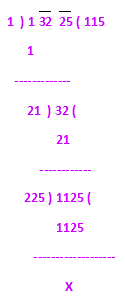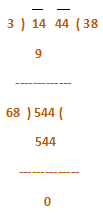CLASS-7
FINDING ROOTS BY DIVISION METHOD
FINDING ROOTS BY DIVISION METHOD
By Division Method –
1) First we have to make pairs of the digits of the given number from to left, if the number of the digit is odd, alone digit will remain at the extreme left of the number, put a small line over each pair of digits.
2) Consider the first pair of digit (or the single unpaired digit) from the left. This is the dividend, find the greatest number the square of which is not more than the dividend. Write this number in the places of the divisor and the quotient.
3) write the square of the number obtained in step 2 below the dividend and subtract, find the reminder if any.
4) write the remainder obtained in step 3 along with the next pair of digits of the given number, this new number is the new dividend.
5) write the first quotient just below the divisor and add them.
6) write the largest possible digit on the right of the sum (obtained in step 5) so the product of the new number and the largest possible digit do not exceeds the new dividend. Subtract it from the new dividend. This largest possible digit will be the second digit of the square root of the given numbers.
7) Write the remainder obtained in step 6 along with the next pair of digits of the given number. This number is the new dividend. Repeat the process till all the pairs of the given number are exhausted.
Example –
1) Find the square root of 13225

Step.1 – Here we can see that in the given number 13225, extreme left number is odd pairs, so extreme left digit 1 will be alone and we make pair with rest of the numbers such as 32 & 25
Step.2 – The greatest number, the square of which does not exceeds 1, that is 1 itself, so we will write 1 in the divisors and quotient places.
Step.3- Write 1², which is 1 and place below 1 and subtract. The reminder is 0
Step.4- The new dividend is 32- the reminder along with the second pair.
Step.5- Write the quotient 1 below the divisor 1 and add or multiply by 2 with quotient 1
Step.6 – The largest possible digit that can be written next to new obtained 2 such that the product of the new number and that digit does not exceed 32 is 1 write the 1 next to divisor and find 21 as the new divisor and place 1 in the quotient places.
Step.7 - Now we will recall the table of 21 and we find 21 is the highest number which can be put below 32 and find the reminder 11.
Step.8 – Now we take the next pair of numbers which is 25 and this number is placed after reminder 11, now the number stands 1125 which is considered as a dividend.
Step.9 – Write the quotient 11 below the divisor 11 and add or multiply by 2 with quotient 11 and we find 22.
Step.10 – The largest possible digit that can be written next to new obtained 22 such that the product of the new number and that digit does not exceeds 1125 is 5, so write the 5 next to divisor and find 225 as new divisor and place 5 in the quotient places after 11.
Step.11- Now we will recall the table of 225 and we find 1125 is the highest number which can be put below 1125 and find the remainder 0 .
Step.12 – So, we have got the final number as quotient which is 115.
2) Find the square root of 1444

Step.1 – Here we can see that in the given number 1444, extreme left number is even pairs, so we make a pair of the given numbers such as 14 & 44
Step.2 – The greatest number, the square of which does not exceed 14, that is 3 itself, so we will write 3 in the divisors and quotient places.
Step.3- Write 3², which is 9 and place below 14 and subtract. The remainder is 5
Step.4- The new dividend is 544 - the remainder along with the second pair.
Step.5- Write the quotient 3 below the divisor 3 and add or multiply by 2 with quotient 3
Step.6 – The largest possible digit that can be written next to new obtained 6 such that the product of the new number and that digit does not exceed 544 is 8 write the 8 next to divisor and find 68 as new divisor and place 8 in the quotient places.
Step.7- Now we will recall the table of 68 and we find 544 is the highest number which can be put below 544 and find the remainder 0.
Step.8 – So, the desired obtained number as quotient is 38